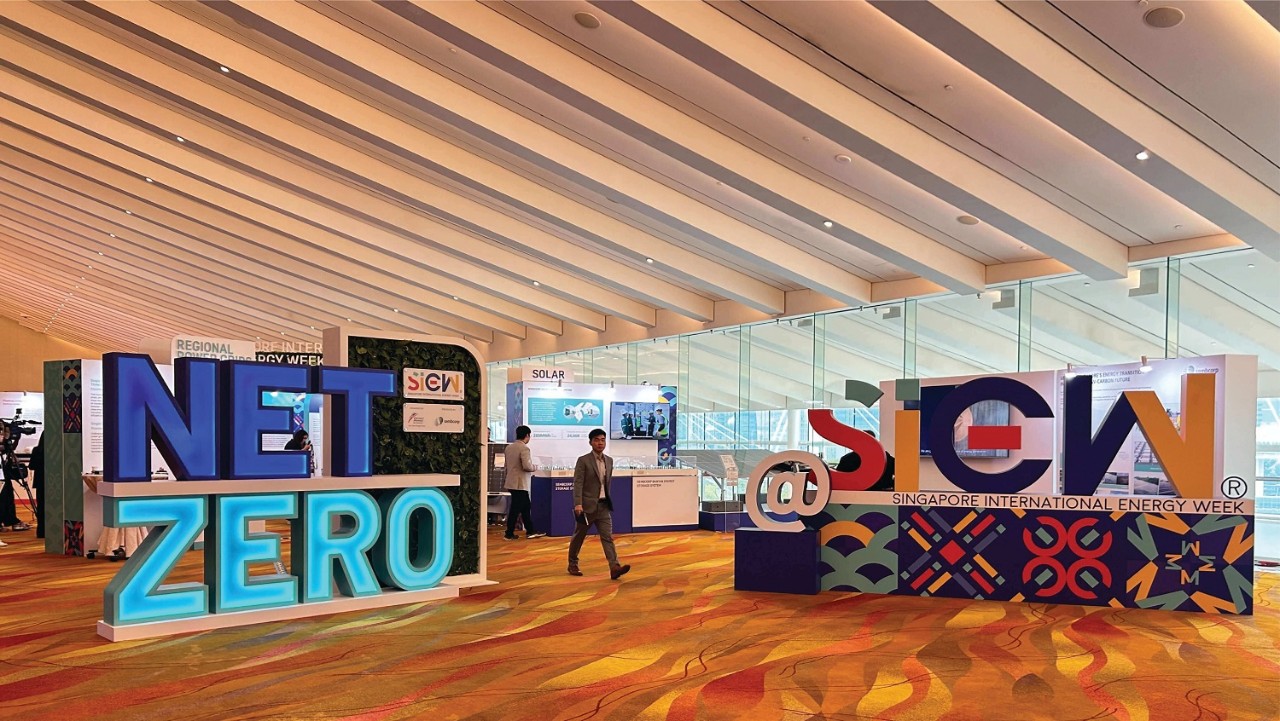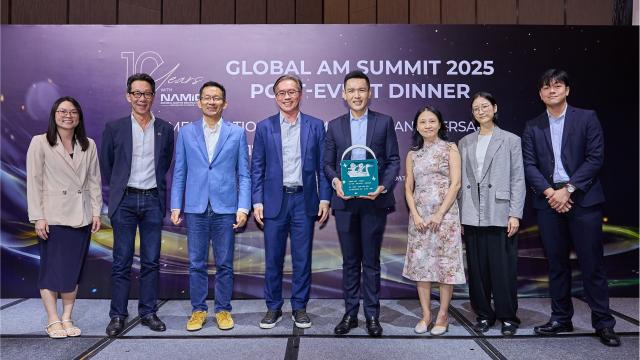Professor Lock Kai Sang, who heads the Energy Efficiency Technology Centre at SIT, spoke at the Singapore International Energy Week (SIEW) 2023 Thinktank Roundtable on "Net Zero Buildings in Singapore, Is It Achievable?".

Themed "Energy Transition Towards a Net-Zero World", SIEW 2023 was held at the Marina Bay Sands Convention Centre. (Photo: Energy Market Authority)
In the pursuit of a sustainable and environmentally conscious future, the concept of net zero buildings has emerged as a beacon of innovation and responsibility within the construction industry. With the global building sector being responsible for 40% of energy consumption and 33% of greenhouse gas emissions, this is a crucial issue to solve if we want to create a sustainable future.
To explore potential solutions to this pressing conundrum, the Singapore Green Building Council and SIT led a thinktank roundtable on 27 October 2023 during the Singapore International Energy Week (SIEW) conference.
Professor Lock Kai Sang, who heads SIT’s Energy Efficiency Technology Centre (EETC), opened the session with his presentation on the opportunities and challenges of achieving net zero buildings in Singapore. He defined net zero buildings as buildings that:
-
Minimise its carbon footprint and energy consumption;
-
Use energy-efficient strategies and appliances;
-
Generate their own renewable energy;
-
Purchase clean energy credits or carbon offsets when unable to generate enough renewable energy.
What It Means for Buildings to Be Net Zero
Professor Lock Kai Sang speaking at the SIEW 2023 Thinktank Roundtable. (SIT Photo)
In moving towards the net zero vision, Prof Lock highlighted that building owners must set clear targets as there are several perspectives they can take. Do they want to achieve net zero in their buildings’ day-to-day operations, or entire lifecycle which includes embodied carbon during the construction phase and end-of-life demolition and disposal? Determining this can help them to chart the way forward.
“There are opportunities in reducing energy consumption, both in existing and emerging technologies,” said Prof Lock. One such solution that can deliver significant energy savings and reduce carbon emissions is the Smart Damper for HVAC (heating, ventilation and air conditioning) systems. It allows facility managers to create micro zones within a building and isolate the zones where air conditioning is not required after certain hours.
Another solution is peak shaving, where electrical power demand is reduced when the network capacity is stressed. This save building owners the need to invest in network expansions to support their peak demand. At a large scale, this reduces the need for new power plants in Singapore. SIT’s upcoming Punggol campus will be a test-bed for peak shaving technology, among other clean energy ideas such as the vehicle-to-grid technology.
Using innovative “green materials” during construction can also reduce a building’s lifetime carbon emissions. Prof Lock noted that SIT has several industry collaborations with construction companies to develop ultra-low carbon concrete, steel made using 100% scrap metal, and pre-engineered steel concrete composite structures, which have reduced greenhouse gas emissions by 40%.
To support the adoption of these solutions, Prof Lock noted that Singapore must have the right policies to drive behavioural change and technology shifts within the building sector. Another opportunity lies in equipping competent and committed people with “green skills” in designing and retrofitting buildings with sustainable infrastructure.
The Sum of Multiple Net Zero Ideas
On the panel: (From left to right) Assistant Professor Elsa Feng, SIT; Professor Lock Kai Sang, Head, EETC, SIT; Mr Francesco Muggeri, Vice President of Power Discrete and Analog Products (APeC & China), STMicroelectronics; Ms Irene Yong, Director (Building Services), Beca; Mr Wang Zhenglin, Senior Manager (Energy-as-a-Service), Keppel Infrastructure. (SIT Photo)
While developing a pipeline of engineering talent in industrial energy efficiency is one area that SIT is already doing, Prof Lock mentioned during the panel discussion, facilitated by SIT Assistant Professor Elsa Feng, that embarking on applied research projects with the industry is another area in which academia can contribute to.
As an institute of higher learning, SIT can collaborate with the industry and be a testbed and living lab to demonstrate research outcomes of new energy-efficient and clean energy technologies. Without any proof of concept, the industry would understandably be hesitant to buy and use emerging green technologies.
Fellow panellist Ms Irene Yong, Director (Building Services) of engineering consultancy firm Beca affirmed this, sharing that their clients often ask about track records before investing in emerging technologies. Industry partnerships with IHLs in testing out new technology, supported by financial incentives from the government, can help the building sector transition towards the net zero movement.
Another panellist Mr Francesco Muggeri, Vice President of Power Discrete and Analog Products (APeC & China) from STMicroelectronics, mentioned the need to put client and consumer pressure on companies to go green. By choosing to only work with companies that are net zero, our society can start a chain reaction to push more companies to decarbonise.
The final panellist, Mr Wang Zhenglin, Senior Manager (Energy-as-a-Service) from Keppel Infrastructure, highlighted that there are more off-site decarbonising solutions coming to the market. For instance, Keppel has conditional approval from the Energy Market Authority to import up to 1.3 gigawatts of renewable energy from overseas. Keppel and other market players are also looking to bring in hydrogen power, ammonia power and other forms of low-carbon electricity in the long term. This would give local building owners more options, in addition to the existing solutions of renewable energy certificates (RECs) and offsets.
To wrap up the fruitful roundtable discussion, Prof Lock reminded the audience: “In Singapore, we are limited with our land space. One square foot is easily $2,000. Instead of looking for valuable space in our buildings to install solar panels, we must find other solutions that are more suitable for our local context. Let’s collaborate, work together and move forward.”















![[FA] SIT One SITizen Alumni Initiative_Web banner_1244px x 688px.jpg](/sites/default/files/2024-12/%5BFA%5D%20%20SIT%20One%20SITizen%20Alumni%20Initiative_Web%20banner_1244px%20x%20688px.jpg)


